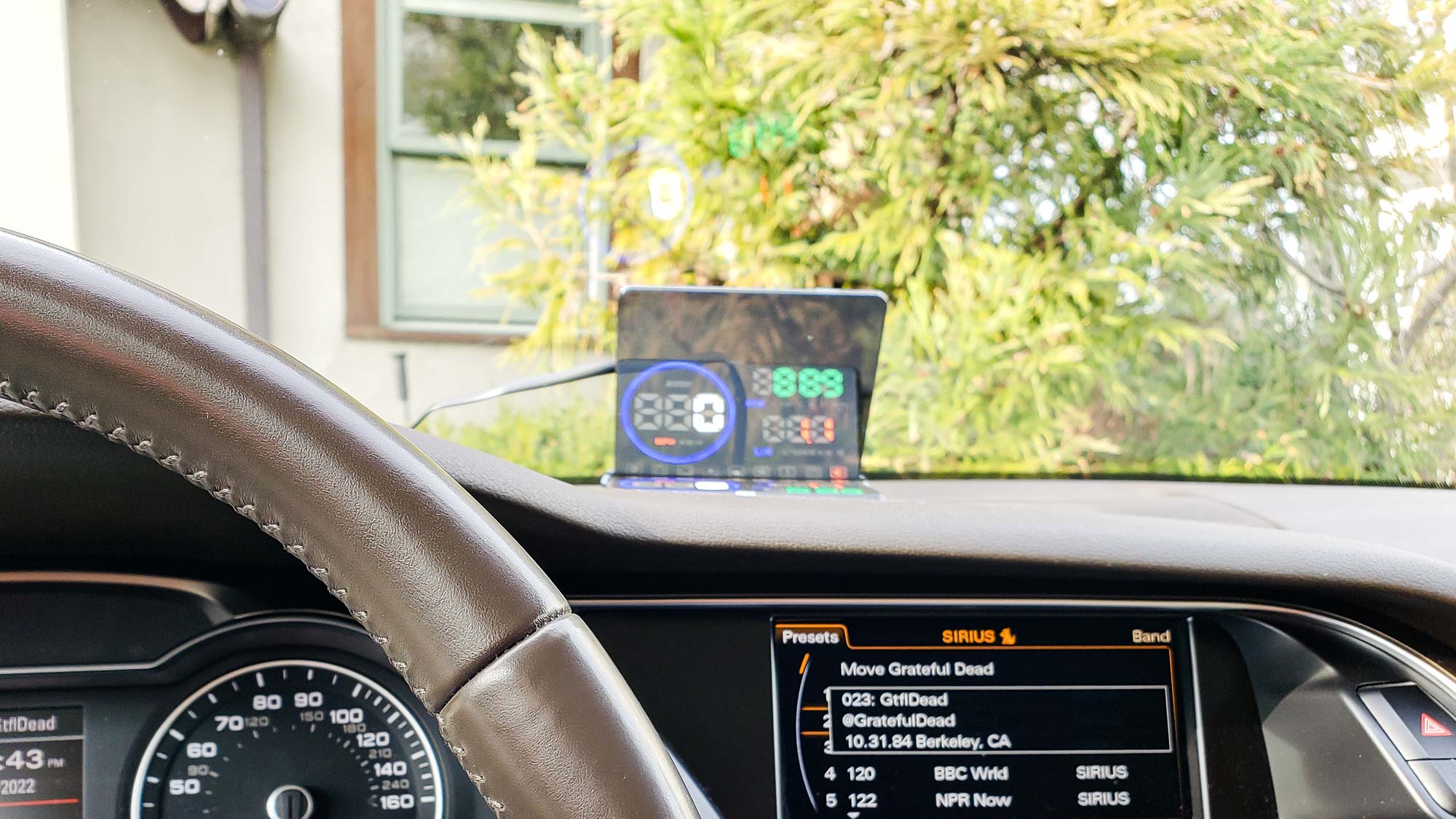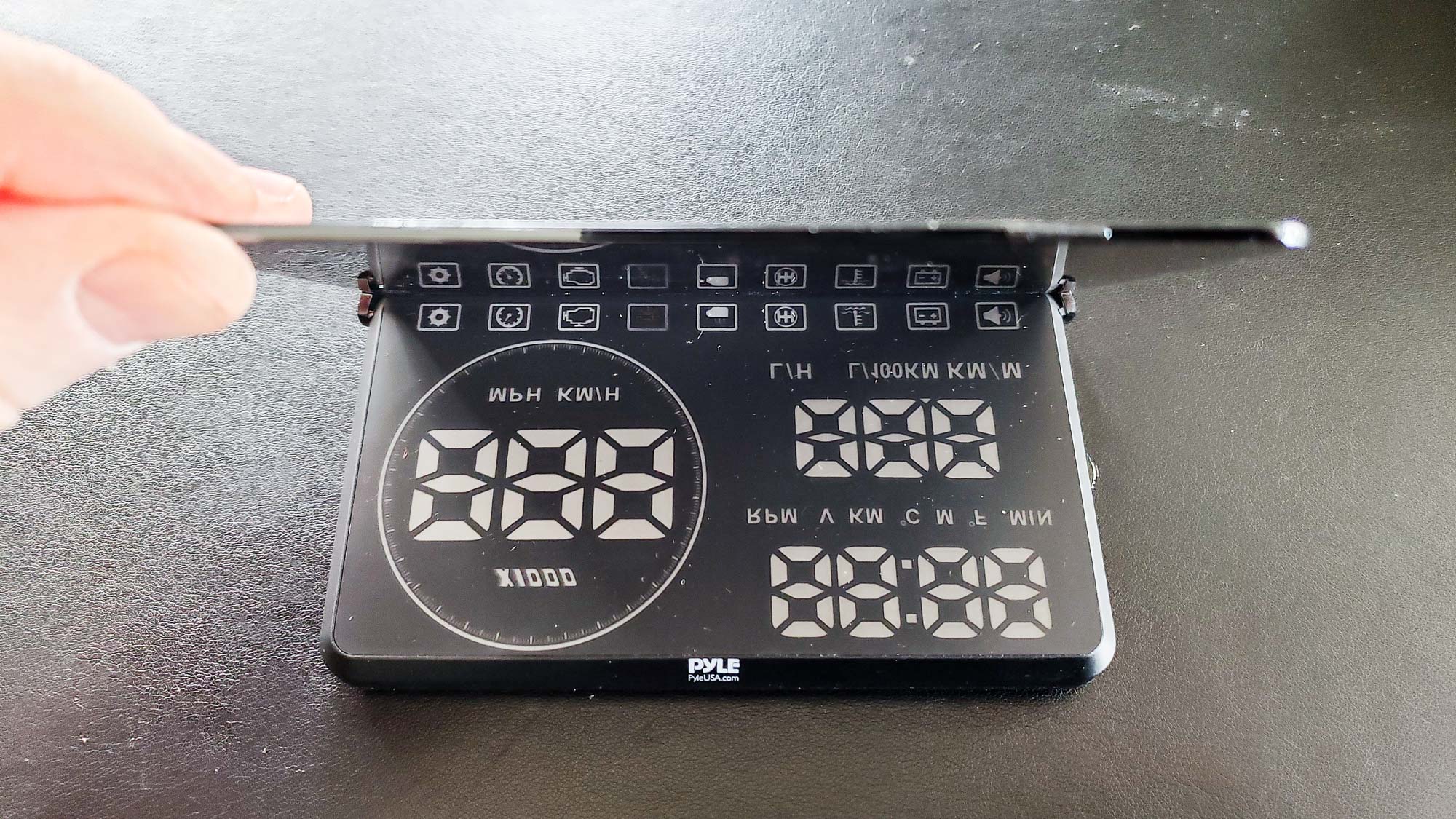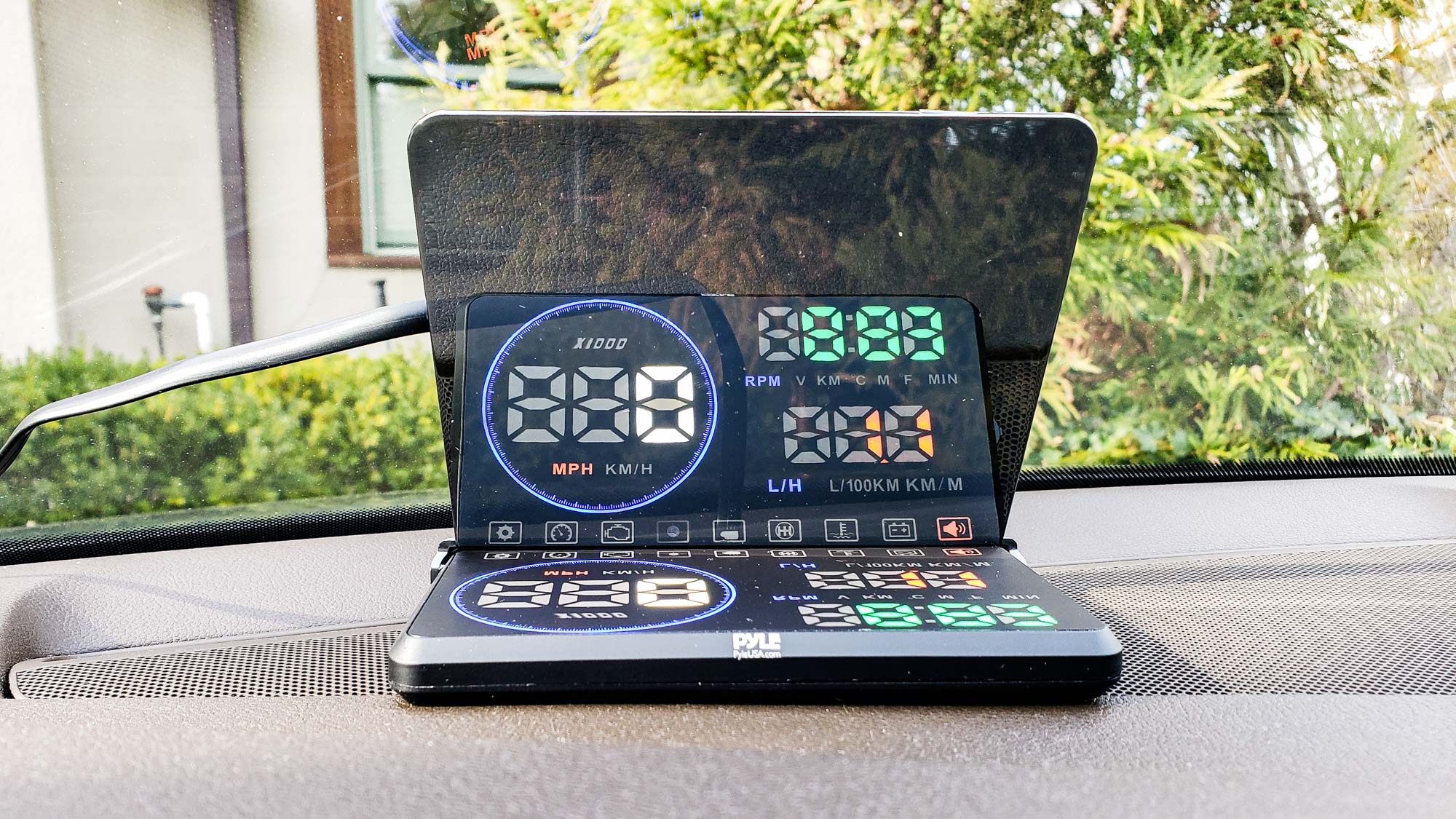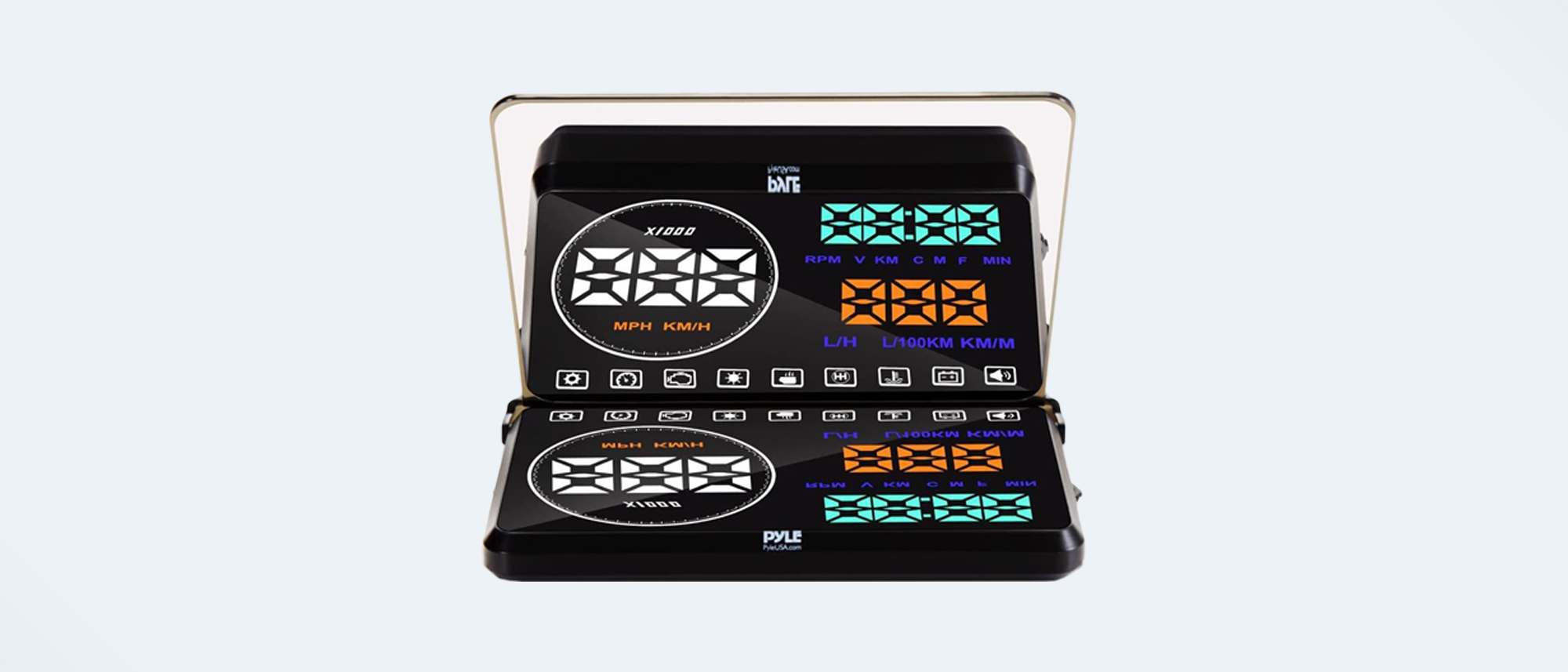Tom's Guide Verdict
With its own reflective screen, large bright display and the ability to show more than two dozen automotive parameters, the Pyle PHUD180BD is one of the best add-on heads-up displays available. Sadly it can get in the way of seeing the road ahead.
Pros
- +
Self-contained screen
- +
Excellent assortment of read-outs
- +
Bright display
Cons
- -
Projection screen can get in way
- -
No phone integration
Why you can trust Tom's Guide
Size: 5.3 x 3.0 x 0.5 inches
Weight: 4.4 ounces
Power: OBD2 port
Display size: 5.5-inches
Color/Monochrome: Color
Number of parameters displayed: 14
Alarms: Yes
Better known for making inexpensive audio amplifiers, Pyle has branched out into automotive heads-up displays - with an emphasis on bold graphics to showcase key car data. With a bright 5.5-inch display and colorful output, the Pyle PHUD180BD conveys a lot of information, from the car’s speed to engine RPMs to a variety of alerts.
The unit includes its own integrated projection screen or can be set up with the included windshield screen. On the downside, it inserts an annoying blind spot that can get in the way of being able to see what’s on the road ahead. However, at $67, the PHUD180BD is a reasonably priced way to put a lot of relevant information in your face — earning it a place on our list of best car heads-up displays.
Pyle PHUD180BD review: Price and availability
At $67, the Pyle PHUD180BD might seem mid-priced, but compared to more expensive competitors it’s an absolute steal. This HUD offers more data, better presentation and a stable base, but for a much lower price. By contrast, the company’s $40 PHUD12 cut some corners with a 3.5-inch display screen, less data and is meant to be viewed directly.
Pyle PHUD180BD review: Design and features
One of the thinnest add-on HUD systems available, the PHUD180BD’s case is made of smooth black plastic that stands in contrast to the Dagood A8’s cringe-worthy fake leather surface. Its 5.5-inch LCD display projects an image onto an angled reflective screen that snaps onto the base or a stick-on windshield screen.
At 5.3 x 3.0 x 0.5 inches, the unit itself is slightly thinner than the Dagood A8 and weighs 4.4 ounces. Its projection screen rises to 4.2-inches above the dashboard, which can block the view ahead, and can’t be folded down when not in use.

Like many of its competitors, the PHUD180BD gets its data and power from the car’s OBD port. The system comes with a flat 69-inch OBD cable that plugs into the unit’s rear mini USB port and can easily be hidden in dashboard crevices. On the left side is an on/off switch, while a control wheel for changing the system’s settings can be found on the right.
The center of attention is the PHUD180BD’s 5.5-inch color screen. It shows 14 individual items and has a large zone for speed complete with engine RPMs underneath. A colored circle separates it from the other items, but it doesn’t correspond to engine speed — as is the case with the Dagood A8.
There are smaller spots that are home to engine speed and fuel economy. Like the typical car dashboard, the Pyle PHUD180BD has iconic warning indicators for things like the battery, coolant temperature and compass bearing. It’s also capable of displaying Metric or Imperial units.
Like other HUDs on the market, the PHUD180BD has a number of alarms. They include a gear shift reminder and one for speeding, though sadly the device lacks the phone integration of the Hudway Drive. That means it can't utilize GPS, offer directions or display text messages.
Pyle PHUD180BD review: Setup
The PHUD180BD works with all cars that have an OBD2 or EUOBD data port. It might have trouble with trucks, however.
Happily, it easily plugged into my car’s OBD port, although its short connector can be hard to remove and might require the use of a set of pliers. The kit included a soft rubber pad that the PHUD180BD solidly sat on, though a bumpy country road proved to be enough to dislodge it.

The unit was easy to turn on with the small switch on the left. I was able to adjust its operations using the wheel but it was too small to be comfortably used. Along with a 1-year warranty, the PHUD180BD comes with a 10-page booklet that explains the PHUD180BD’s main functions along with a brief troubleshooting section.
Pyle PHUD180BD review: Performance
A few seconds after plugging the PHUD180BD’s cord into my car’s OBD port, the screen came to life showing me the car’s engine speed and fuel use. It can be set to shut itself off immediately after the car is turned off, or for as long as 15 minutes after.
Its dual-core processor never lagged, updated data quickly and the graphics are among the best for heads-up displays. Regardless of whether it was a bright sunny day or a moonless night, the screen worked well with easy to read parameters that didn’t take long to view at a glance.
On the downside, the reflective projection screen interfered with my field of view regardless of where I put it. The Pyle HUD kit provided the choice of using a stick-on screen, which was included in the box, that can be applied to the inside of the windshield.

Should something go wrong inside the car, the PHUD180BD’s OBD icon will turn on. However, you will still need to get out a full OBD scanner to identify what the problem actually is. Unlike the Akabane A500, the PHUD180BD lacks acceleration or braking test routines. So if you’re all about testing your car’s performance, this won’t be for you.
Pyle PHUD180BD review: Bottom line
One of the best add-on heads-up displays available, the Pyle PHUD180BD’s large bright display is complemented by its integrated projection screen. It shows a good mix of operation parameters, warnings and notification of a diagnostic fault.
In short, the Pyle HUD is able to tell you what’s going on inside your car without forcing you to take your eyes off the road. Unfortunately it can get in the way of the driver’s vision, but it’s worth a lot more than its $67 price tag — especially for drivers who thirst for automotive information.
Brian Nadel is a freelance writer and editor who specializes in technology reporting and reviewing. He works out of the suburban New York City area and has covered topics from nuclear power plants and Wi-Fi routers to cars and tablets. The former editor-in-chief of Mobile Computing and Communications, Nadel is the recipient of the TransPacific Writing Award.


